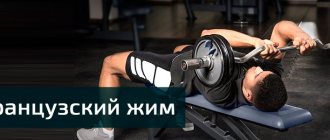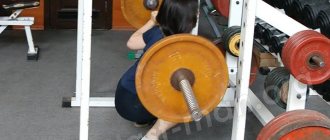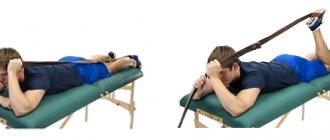Preparing for childbirth: what role do physical education and gymnastics play?
Why is physical preparation necessary for childbirth? Gymnastics and special physical exercises performed regularly during pregnancy will allow the baby to be born faster and reduce the risk of complications and injuries for him and the mother.
It is important to remember something else. Not every woman can boast of ideal physical condition before pregnancy, so carrying a baby, especially in the last months, turns into a heavy burden for many women. This is why you should do gymnastics or other physical exercises from the first weeks of pregnancy, and not a few days before giving birth.
Recommendation 1: stop taking medications
The most important rule for women in the first trimester of pregnancy is to avoid taking medications. The medications you took before pregnancy cannot be used in the first trimester of gestation.
In the early stages of pregnancy, the formation of fetal organs occurs, and any drug can negatively affect this process. Therefore, before you swallow a tablet, powder or syrup, think carefully and be sure to consult with your obstetrician-gynecologist. If you have any chronic disease that requires medication, you should also consult a specialist.
Recommendation 2: Avoid strenuous physical activity
Is it possible to play sports in the first trimester? Not only is it possible, but it is necessary! Exercising during pregnancy is the key to excellent mood, good physical shape, normal weight, absence of constipation and swelling. In addition, sports allows you to prepare your body for the upcoming birth.
If before pregnancy you did Pilates, yoga, or swimming, then in the first trimester of gestation you don’t have to give up your favorite activities. But it’s not worth learning new sports. Unusual exercises and loads for the body can negatively affect the course of pregnancy.
Heavy physical activity is prohibited in both early and late stages of pregnancy. For example, you cannot jump into water from a tower, ride horses, or go rock climbing. If you were previously into running, then during pregnancy it is better to replace running with brisk walking.
What exercises are recommended during pregnancy?
Several groups of exercises can be distinguished. They are aimed at training and strengthening certain muscle groups and ligaments. The main ones are the muscles of the back, chest, and limbs. It is useful to work out all joints, especially the hips.
General exercises
Aerobics for pregnant women - warm-up for the neck, limbs, back. Movements should be smooth, without much effort. Among the auxiliary items, a mat, a small ball, a towel, dumbbells up to 1 kg, a fitball, and a chair will be useful. The set of exercises includes:
- Rotations, bends, head turns.
- Raising the arms, rotating the shoulder, elbow, and wrist joints. Abduction of the arms, bent at the elbows and raised to chest level, backwards. At the same time, the shoulder blades are brought together and spread apart.
- The following exercise helps strengthen the chest muscles: bend your elbows and raise them in front of you to chest level, elbows pointing to the sides. Squeeze the palms of both hands with force, hold for a while, then relax. You can take a long towel in your outstretched arms and stretch it in front of you.
- Torso bends can be done in a standing position, sitting on a chair, sitting on the floor with straightened legs and resting on your hands behind you.
- Rotation of the pelvis is done with legs widely spaced. You can perform any smooth dance moves.
- Strengthening the legs: in a standing position and holding onto a support, raise one straightened leg forward, to the side, back, repeat for the other leg. It is useful to stand on tiptoes and walk in place. In a position on the side, the leg that is on top is raised in a bent and straightened position. Lying on your back, you can perform a “bicycle” exercise with your legs bent at the knees.
- Squats during pregnancy are done in the early stages and in a special way. The legs are placed wider, with the toes turned outward so that the knees point to the side. It is better to hold onto a support with your hands, for example, the back of a chair. You need to squat slowly, until about halfway, then stay in this position for a few seconds and return to the starting position.
- Lying on your back, bend your knees, arms lie along your body. Leaning on your hands and feet, raise your pelvis above the floor, stay in this position, and return to the starting position.
- Exercises in a position on all fours: extend one arm forward and the opposite leg. Back bends, torso twists, push-ups in a kneeling position.
- Hanging on the bar.
Many exercises for pregnant women can be done at home. It is important that before this, a specialist checks the technique of their implementation, and includes only useful types of activity in the list. All women have different levels of physical fitness and health conditions, so you should be wary of the recommendations of bloggers, girlfriends and other people if they are not experts.
Breathing exercises
Breathing exercises for pregnant women help relieve stress and enrich the blood with oxygen. Also, breathing practices will be useful for a woman during childbirth, because the depth and frequency of breathing are directly related to the relaxation and contraction of the uterus and abdominal muscles, and affect pain during childbirth. By controlling breathing, doctors achieve a smooth course of labor so that the woman does not suffer ruptures and the child does not suffer from hypoxia. Breathing exercises during pregnancy include practicing:
- Diaphragmatic type of breathing - deep, even, slow. It involves the main respiratory muscle - the diaphragm. When you inhale, the front wall of the abdomen rises, and when you exhale, it lowers. You can control this by placing your hand on your stomach and watching its movements while breathing.
- Breathing “like a dog” is frequent, shallow, with an open mouth and slightly protruding tongue.
- Breathing with a count, when inhalation is performed for “one”, “two”, exhalation - for “one”, “two”, “three”, “four”.
Regularly performing breathing exercises will make them automatic. As a result, the woman in labor will easily follow the doctors’ instructions and alleviate her condition without even thinking about it.
Exercises for the perineum
The Kegel complex is useful for all women - young, old, before and after childbirth. It can be done in a sitting, standing, or lying position. These are exercises during pregnancy for the muscles in the perineal area:
- Contractions of the pelvic floor muscles, as if you need to hold back urination. Muscles tense and relax at a rapid pace.
- Tighten the muscles of the perineum and hold for 5-10 seconds, relax. Gradually lengthen the time to 30 seconds or more.
- Exercise “lift”: contract the muscles of the perineum, then try to tense the muscles located above - at the level of the vagina. Relax in reverse order.
- Alternately contract the muscles in the front of the perineum (around the urethra and the entrance to the vagina) and the back (around the anus).
Trained muscles cope better with the task of expelling the fetus during childbirth, and perineal ruptures are less common. After childbirth, the likelihood of uterine and rectal prolapse and hemorrhoids decreases; after stretching, muscle organs quickly return to their previous shape.
Pool exercises
Exercises for pregnant women in the pool have a good effect on the health of the expectant mother and fetus. At the same time, the load from body weight is significantly reduced, pain and a feeling of heaviness in the back and joints disappear. Muscles that were in a state of spasm relax. An approximate set of exercises:
- Lie on your back on the water in the shape of a “star” and relax.
- Lying on your stomach, swim using only your legs or only your arms. The same is true in the supine position.
- Rotate around its axis in water.
- “Bicycle” during pregnancy under water - a woman holds on to the handrail and performs rotational movements with her legs, as if she were pressing on the pedals of a bicycle.
- “Float”: inhale more air and hold your breath. Group up, clasp your hands around your knees, tucked to your chest. In this position, your back will be visible above the water, and your head will be lowered into the water. Exhale slowly while in water. Return to the starting position and take a new breath, rest.
The pregnant women are supervised by an instructor. He monitors the correctness of the exercises and adjusts the load individually. If the condition worsens, it helps the woman get out of the water, dry herself, and lie down to rest.
Recommendation 3: Avoid long flights
Perhaps in the first trimester of pregnancy you will want to go on vacation to distant countries. For example, to Cuba, Sri Lanka, Tanzania. Vacations in exotic countries are of course good, but your health and the safety of your unborn baby should come first!
During a flight, there is a very large pressure drop, and how your body will bear this load is anyone’s guess. It is likely that everything will go fine, but some problems are possible:
- exacerbation of toxicosis;
- frequent urge to urinate;
- increased fatigue;
- problems with the digestive system;
- dizziness.
In addition, during a long flight you will be constantly sitting. And prolonged sitting can lead to lymphostasis - swelling of the soft tissues. In this regard, it is quite reasonable to replace long flights with shorter travel routes.
Before your flight, be sure to go to an appointment with an obstetrician-gynecologist, who will assess your condition and accurately answer the question: can you fly or not. If you have certain health problems, flying is contraindicated for pregnant women. For example, air travel is prohibited if you have severe anemia.
When going on holiday abroad, do not forget that in many countries in Europe and Asia there is a risk of contracting measles and rubella. And if you did not have measles or rubella as a child or did not complete the full course of vaccination against them, then if you become infected, you will face serious troubles. For example, infection with rubella in the first trimester increases the risk of miscarriage by 4 times.
Recommendation 4: exclude spicy, salty, raw foods from your diet
The importance of proper nutrition in early gestation cannot be overemphasized. The growth and development of your unborn baby largely depends on how you eat. And there are a number of foods that pregnant women should avoid. These include:
- Spicy, salty, smoked foods that put a lot of stress on the liver and kidneys. During pregnancy, these organs already have a hard time. The liver experiences double load due to hormonal changes. In the kidneys in the first trimester, blood flow increases and glomerular filtration increases. Therefore, you should not additionally burden the liver and kidneys with poor nutrition.
- Blue cheese, raw eggs, meat; fish. These products may contain pathogenic bacteria. For the same reason, you should not consume raw milk. Even if you buy milk from a trusted store, it is better to boil it before use.
- Carbonated drinks, which negatively affect the functioning of the intestines, kidneys, and gallbladder, cause bloating and stool upset.
- Coffee. The allowed limit is one cup of coffee per day. Drinking more coffee can increase the muscle tone of the uterus and cause miscarriage.
- Alcohol. Drinking alcohol during pregnancy leads to oxygen starvation of the fetus, delaying its growth and development. Just 3-4 small doses of alcohol can cause alcohol syndrome in the fetus, leading to serious mental and physical abnormalities.
Recommendation 5: Do not wear tight clothes and shoes
In the first trimester of pregnancy, a woman's silhouette changes slightly. Because of this, many pregnant women continue to wear tight-fitting clothes to highlight their figure. However, even in the early stages of pregnancy, it is better to choose loose clothing that does not compress soft tissues, the abdominal area, and mammary glands. Wearing tight clothes can impair blood circulation, lead to lymph stagnation, cause fatigue, and increase the unpleasant symptoms of toxicosis.
What kind of shoes should pregnant women wear? Choose comfortable shoes with solid soles. During pregnancy, the center of gravity gradually changes, and when wearing shoes with heels, the load on the lumbosacral region increases.
If we talk about the cold season, it is better to replace shoes and boots that are very tight on the calf muscles or feet with looser shoes. As with clothing, this will help avoid poor circulation and lymph stagnation.
Recommendation 6: avoid hypothermia and overheating of the body
If before pregnancy you liked to take a steam bath or, conversely, plunge into an ice hole, then during pregnancy you need to reconsider your habits. Overheating and hypothermia are dangerous for the fetus, especially in the first trimester of gestation.
Hypothermia impairs blood circulation, which can cause fetal hypoxia. Also, do not forget that during pregnancy, immunity decreases, which means the risk of colds increases.
Overheating of the body in the early stages of pregnancy negatively affects the formation of the fetus and increases the risk of miscarriage. Therefore, in the first trimester of gestation it is better to avoid baths and saunas. In the second and third trimester, if there are no contraindications, you can visit the sauna and bathhouse.
What are the benefits of warm-ups for pregnant women?
If your doctor allows you to exercise, you should sign up for individual or group classes for pregnant women. The instructor selects simple exercises, a measured rhythm, and sufficient pauses between sets for rest. Along with proper nutrition and exercise regimen, it strengthens the pregnant woman’s body:
- Blood circulation in the mother’s body improves, including blood supply to the placenta and all organs. The delivery of oxygen to tissues increases, which improves the functioning of the heart and kidneys, and the fetus grows and develops correctly.
- Increases resistance to colds.
- Improves mood and sleep. Irritability and resentment disappear, and emotional lability is less pronounced.
- Relieves physical fatigue, pain in the lower back, legs, and swelling.
- Appetite and body weight are normalized.
- If the position of the fetus in the uterus is incorrect, performing exercises can lead to the baby turning in the desired direction.
- Improves intestinal function and digestion in general.
- Less congestion in the pelvic area, which is a prevention of hemorrhoids after childbirth.
To get the most out of your workouts, they need to be done regularly. It is better if classes take place at the same time. It is beneficial to drink water during and after workouts. It should be warm, without gas. You need to drink several sips, 200–500 ml in total.
Recommendation 7: Do not use hair and nail dyes with toxic substances
Of course, even during the period of bearing a child, every woman wants to remain beautiful. Therefore, pregnant women often have a question: is it possible to dye your hair and get a manicure during pregnancy?
You can dye your hair during pregnancy, but you need to choose gentle organic dyes made from natural ingredients. Inorganic paints contain ammonia and other harmful substances that can cause allergies in a pregnant woman and increase symptoms of toxicosis.
The situation with manicure is more complicated. A manicure always begins with removing old nail polish. Remove varnish with acetone and other substances that have a very strong odor. This can cause an allergic reaction in you, even if you were not allergic to acetone before pregnancy. The thing is that during pregnancy, immunity decreases, which means the likelihood of allergic reactions increases. If you still decide to go to the salon for a manicure, then ask the master for a mask that will protect the respiratory tract from harmful substances.
For manicure, you should also choose gentle varnishes that do not contain toxic substances - phosphoric acids, acetone alcohols, formaldehyde.
Conclusion
If there are no threats to your pregnancy, then during the first trimester there are no obstacles to working out your abs, since the belly is not yet large, and physical activity brings many benefits. Next, you can choose alternative exercises for the abdominal muscles to avoid lying on your back.
You must always listen to your feelings. If the exercise is too difficult to perform, you feel discomfort and pain, you should stop immediately.
Before you start pumping up your abs during pregnancy, it is better to consult your doctor about the presence of any contraindications in your case.
Recommendation 8: Accept your pregnancy and your new role as “I am a mother”
In the first trimester of pregnancy, hormonal changes occur in the female body, which affects the functioning of the nervous system. In this regard, a pregnant woman may experience conditions and emotions such as tearfulness, anxiety, and excessive sensitivity. And some pregnant women even feel guilty before others for their whims over trifles, frequent emotional breakdowns.
Feelings of guilt are a negative attitude that must be gotten rid of. After all, such an emotion will cause you psychological discomfort.
Irritability in the early stages of pregnancy is nothing more than an attempt by the female psyche to fully realize and accept the fact of motherhood. And the sooner you accept your pregnancy and your new role as a mother, the sooner your calmness, good mood will return, and you will stop feeling guilty before others.
Contraindications and risks when performing exercises during pregnancy
Before starting training for pregnant women, consultation with a doctor and diagnosis are required. There are conditions in which movements need to be kept to a minimum. In some cases, the woman is even “put into storage”; she is kept in the department under the constant supervision of doctors. The most common contraindications for physical education:
- threat of miscarriage;
- history of miscarriages;
- placenta previa;
- severe gestosis in a pregnant woman;
- high blood pressure, tachycardia;
- cervical abnormalities.
The doctor knows the full list of contraindications. After examining the pregnant woman, he makes recommendations on nutrition, daily routine, and says whether it is possible to do gymnastics during pregnancy. The actual set of exercises for pregnant women is compiled by a physical therapy instructor, taking into account the doctor’s opinion.










